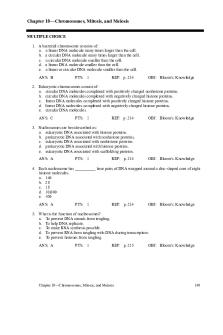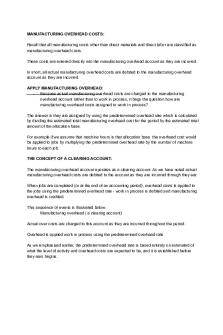GOOD Manufacturing Practice PDF

| Title | GOOD Manufacturing Practice |
|---|---|
| Course | Fundamental Therapeutics - From Molecule To Medicine |
| Institution | University of Sunderland |
| Pages | 4 |
| File Size | 268.2 KB |
| File Type | |
| Total Downloads | 113 |
| Total Views | 145 |
Summary
Lecturer: Shu Chaw
A lot of extra information given in lecturer that was not given in slides ...
Description
GOOD MANUFACTURING PRACTICE The Values of GMP: SISPQ Safety -
The product remains free of any unexpected side effects when it is used appropriately by the patient
Identity -
The product is exactly what the label and related materials say it is Every material, components, significant piece of equipment and operation are labelled and documented so that batch history can be accurately reconstructed from start to finish
Strength -
The product delivers the correct dose and its potency is maintained over the shelf-life of the product
Purity -
The product is free from physical, biological and chemical contaminations
Quality -
The product meets the standards and expectations of medical professionals and regulatory agencies around the world The product performs as claims The product can be successfully made in a consistent manner
QUALITY CONTROL (QC) -
Part of GMP and QA Sampling, specification, testing, documentation, release procedures Objective: Defined process, when followed, will yield a product complying with its specifications QC department independent of other parts
Cleaning and GMP -
-
Precision cleaning is fundamental and critical part of production Controlled by appropriate standard operation procedures (SOPs) Must remove or neutralise contaminants such as: Particulate matters Chemicals Micro-organisms Any liquids, including cleaning and disinfecting agents should be treated as contaminants Prove and document that facility or equipment is clean and free of any possible contaminants
Determination of Limits for Residues -
-
‘Residual limit’: applies to matter left on a surface after cleaning Amount of matter specified by the residual limit does not impact adversely on the next product batch To define a residual limit, consideration must be given to: Product type Solubility of active ingredients Ease of cleaning How long equipment might stand idle How effective the test residues can be recovered after cleaning Toxicity of substances & ability to analyse them accurately are key factors Use of pharmacological dose, lowest production dose etc. Examples: The level of active contaminant should not exceed one thousandth of its lowest daily therapeutic dose, divided by the highest daily therapeutic dose or no more than 0.1% of the normal therapeutic dose Acceptable daily intake (ADI) to determine residual solvent limits No more than 10ppm of drug will appear in the next product Visual detection may be adequate where compounds are not considered toxic Worst case scenario: single point contamination caused by pockets of residuals, not evenly distributed throughout the product
Sampling -
Three common methods: 1. Rinse analysis Taking a sample from the final rinse water/solvent used in the cleaning process Rinsing equipment surface with known quantity of solvent Allow sampling of large area – Very useful for difficult to reach areas such as pipe works
2. Surface analysis
Swab, soaked with solvent, is wiped over known surface area Amount of contaminant analysed chemically Can reveal type and level of contaminations Only useful for limited and easily reached surface areas Amount of contaminant that can be identified depends on amount of solvent absorbed by the swab 3. Placebo analysis Running a dummy batch of inert material directly after cleaning has finished Applicable only to product contact parts (punches of tablet press) Can potentially dilute contamination and thus disguise it
Validation -
Means to prove that GMP has been achieved Combination of specific practices and procedures Provides documented assurance that pre-determined specifications are met Producing, recording, collating, arranging documents Core elements: Procedures, Protocols, Testing Five disciplines in validation: 1. Process validation 2. Equipment and utilities validation 3. Computer validation 4. Analytical validation 5. Cleaning validation
Packaging and Labelling
-
Part of GMP Means of providing protection Means to present the dosage form Means to protect from misuse In some instances, packaging and product not to be separated Containers vary with dosage forms...
Similar Free PDFs

GOOD Manufacturing Practice
- 4 Pages

Ch 10 - GOOD PRACTICE
- 15 Pages

Deconstruct - good to practice
- 3 Pages

GMC Good-medical-practice
- 40 Pages

Good-Medical-Practice
- 22 Pages

Code of Good Subtitling Practice
- 2 Pages

Guide to good dispensing practice
- 19 Pages

Pharm quiz 1 - good practice
- 15 Pages

Manufacturing Costs
- 8 Pages

Handout-Manufacturing
- 16 Pages

Manufacturing notes
- 3 Pages
Popular Institutions
- Tinajero National High School - Annex
- Politeknik Caltex Riau
- Yokohama City University
- SGT University
- University of Al-Qadisiyah
- Divine Word College of Vigan
- Techniek College Rotterdam
- Universidade de Santiago
- Universiti Teknologi MARA Cawangan Johor Kampus Pasir Gudang
- Poltekkes Kemenkes Yogyakarta
- Baguio City National High School
- Colegio san marcos
- preparatoria uno
- Centro de Bachillerato Tecnológico Industrial y de Servicios No. 107
- Dalian Maritime University
- Quang Trung Secondary School
- Colegio Tecnológico en Informática
- Corporación Regional de Educación Superior
- Grupo CEDVA
- Dar Al Uloom University
- Centro de Estudios Preuniversitarios de la Universidad Nacional de Ingeniería
- 上智大学
- Aakash International School, Nuna Majara
- San Felipe Neri Catholic School
- Kang Chiao International School - New Taipei City
- Misamis Occidental National High School
- Institución Educativa Escuela Normal Juan Ladrilleros
- Kolehiyo ng Pantukan
- Batanes State College
- Instituto Continental
- Sekolah Menengah Kejuruan Kesehatan Kaltara (Tarakan)
- Colegio de La Inmaculada Concepcion - Cebu




